Looking into Language: A Study of How Medical Students View Disability
The following is my second critical annotation for the semester.
—
In the paper “What does ‘disability’ mean for medical students? An exploration of the words medical students associate with the term ‘disability,’” Margaret Byron and her colleagues discuss a study they carried out to assess the concepts, descriptors, and images that medical students associate with disability. With a twofold purpose of understanding how better to teach medical students about disability and determining whether a short course would change the way that medical students think about the issue, the researchers analyzed the words that students associated with disability before and after a four-day course. They found that before the course, the students tended to use negative and depersonalizing terms associated with loss, victimization, and the medical model of disability (which holds that disability derives solely from impairment in the body), and that afterward, they tended to use more positive terms associated with personal empowerment and the social model of disability (which holds that disability is the result of inaccessible architectural and social environments). While the authors’ research is cause for cautious optimism about the potential of a disability course to change hearts and minds, Byron and her associates fall short of a more rigorous analysis that would move past the problem of language and into the social construction of disability that underlies language. In the study, this problem manifests itself in three ways: in the uncritical assumption that certain words, when applied to disabled people, are inherently positive or negative; in the idea that one should attempt to see the person, not the impairment; and in the ways in which the students interacted with disabled people.
At the time of the study, the lead researcher, Margaret Byron, was a Senior Lecturer in Disability at the University of Bristol and the Project Director for Partners in Practice, where she worked to create equality in healthcare for disabled people; not surprisingly, her aims in the larger world inform the purpose and the methods of her research. For the study, carried out between 1996 and 2000, four sets of students participated in a four-day course taught by fourteen different teachers, eleven of who were disabled. While 381 students began the course, only 189 completed it. Before and after the course, the students wrote down two words that they associated with disability. Two professionals associated with the course used statistical analysis to analyze the words according to frequency of use and a series of dichotomies that consisted of a) symbolic icons versus personal qualities, b) the language of loss and deficit versus the language of empowerment and ability, and c) the medical model versus the social model. The purpose was to discover whether the words the students associated with disability changed after they had participated in the course. In 1999, the researchers also held a focus group before and after the course, in which a small number of students participated in open-ended discussions on disability issues (Byron et al. 2005, 176-179).
The results of the study showed a shift in the students’ associations with disability from concepts embedded in the medical model to those embedded in the social model. Before the course, the majority of the words used ten times or more included words associating disability with pity, difficulty and suffering, while after the course, the majority of the words used ten times or more were associated with empowerment and independence (Byron et al. 2005, 179). Moreover, the dichotomies shifted significantly. The use of depersonalized visual icons to describe disabled people (“wheelchair,” “white stick,” “orange badge,” “bobbles on the pavement”) shifted from 29% of the words to 7%, while terms associated with personal qualities increased (Byron et al. 2005, 180-182). In fact, terms denoting what the authors call “positive” personal qualities (“strength,” “capable,” “real people,” “normal person,” “your average Joe”) increased by 44% and terms associated with what they deem “negative” personal qualities (“dependence,” “inadequate,” “suffering”) decreased by the same amount (Byron et al. 2005, 180-182). In addition, words associated with loss and deficit decreased by 33%, while words associated with empowerment increased by 42% (Byron et al. 2005, 180). The shift was summed up in a 27% decrease in the use of the medical model, and a 39% increase in the use of the social model (Byron et al. 2005, 180). While noting that these changes might have derived simply from the students parroting back new concepts after the course, the researchers conclude that the changes are inherently positive and bode well for future courses on helping medical students view disability differently (Byron et al. 2005, 182-183).
From my perspective, however, a failure to grapple with several core issues makes the researchers’ conclusions questionable. For example, the study suggests that the term “normal person” has positive implications (Byron et al. 2005, 182), while the word “dependence” has negative implications (Byron et al. 2005, 180). But only in an ableist society would the word “normal” carry a positive valence; as Lennard J. Davis points out in “Bodies of Difference: Politics, Disability and Representation,” the concept of normal exercises a great deal of social and psychological tyranny over people’s lives because it is a simply a statistical average and a social construct that cannot be attained by anyone. As Davis writes, the construction of the category of normal creates the marginalization of disabled people:
Under normalcy, no one is or can be normal, just as no one is or can be equal. All have to work hard to make it seem that they conform, and so the person with disabilities is singled out as a dramatic case of not belonging. This identification makes it easier for the rest to think they fit the paradigm. (Davis 2002, 105)
Moreover, only in an ableist society, in which the values of individualism and independence are held in high esteem, could a term like “dependence” take on a negative valence. Dependence on others for help need to not be seen as infantilization, helplessness, or tragedy, but as an indication of the interdependence of all human beings and as a reflection of a basic human need for assistance and comfort. The failure of the study to investigate the implications of these types of words lessens its usefulness is terms of understanding how to change thinking about disability.
In addition to not addressing the ableist implications of words deemed “positive” or “negative,” the authors of the study fail to consider one of the most troubling aspects of the ways in which people have attempted to address the issue of terminology: an insistence upon person-first language. The logic of person-first language is to put the person before the disability; proponents of person-first language use the term “person with disabilities” rather than the identity-first language of “disabled person.” The underlying idea of person-first language is that one should “see the person, not the disability.” The study by Byron and her associates echoes this kind of thinking; in commenting upon the students’ increased use of terms describing “positive” personal attributes, the authors note that this outcome “fit well with the aims of the course, which were that the student should see the person, not the impairment, and should understand the social model of disability” (Byron et al. 2005, 182). However, inherent in person-first language is the implication that disabilities render one less of a person. After all, why say, “See the person, not the disability” rather than “See the person and the disability,” unless disabilities seem somehow dehumanizing? Moreover, person-first language asks the speaker to not see what is already apparent: a difference that has a significant impact upon a disabled person’s everyday experience. This type of denial is not a feature of the social model of disability, whose adherents tend to prefer identity-first language and to be seen as fully human with their disabilities, not despite them (Shakespeare 2010, 268-269). Thus, in their uncritical acceptance of the imperative to separate the person from the disability, the researchers fail to address the negative view of disability that underlies this approach and do not realize the extent to which it conflicts with the social model.
Finally, while the authors seek to break down barriers between medical students and disabled people, they do so in a way that continues to make disabled people seem alien and apart. For example, they provide opportunities for the students to interact with disabled people, but their methods make these visits akin to a special field trip or exhibit. The point of the interactions seems to be for able-bodied students to learn about the patients’ disabilities, not to befriend them, to spend time with them on their own terms, or to learn about their lives as disabled people in an exclusionary society. Instead, the emphasis is medical — which is understandable, given the context, but not particularly useful in terms of changing perceptions of disabled people as simply having defective bodies in need of care. The response by one student in a focus group shows the continued impact of the medical model even after a four-day course based on the social model. The student depersonalizes the disabled people she had come into contact with during the course by referring to them by their disabilities only: “It’s good that you can kind of pick what you enjoy doing. Like today you could have picked either learning, or vision or hearing and you can pick what you enjoy and what you want to learn more about, which is good.” (Byron et al. 2005, 182) In other words, the student learned about the patients’ medical conditions — their learning challenges, their sight, their hearing — rather than about the patients as whole people in a social context.
No amount of changing the language about disability will change the position of disabled people in society without serious attention paid to underlying attitudes. While I applaud the work being done to help people talk about disability differently, that work is only the beginning of a long process of understanding how people think about disability and why. As S.E. Smith writes in “Language Matters, But It’s Not the Most Important Thing,” the issue “isn’t the word, it’s what lies behind it. It’s what the word reinforces and reveals.” (Smith 2011)
Sources
Byron, Margaret, Zoë Cockshott, Hilary Brownett, and Tina Ramkalawan. “What does ‘disability’ mean for medical students? An exploration of the words medical students associate with the term ‘disability’.” Medical Education 39 (2005): 176–183. doi:10.1111/j.1365-2929.2004.02062.x.
Davis, Lennard J. “Bodies of Difference: Politics, Disability and Representation.” In Disability Studies: Enabling the Humanities, edited by Sharon L. Snyder, Brenda Jo Brueggemann, and Rosemarie Garland-Thomson, 100-106. New York, NY: Modern Language Association of America, 2002.
Shakespeare, Tom. “The Social Model of Disability.” In The Disability Studies Reader, edited by Lennard J. Davis, 266-273. New York, NY: Routledge, 2010.
Smith, S.E. “Language Matters, But It’s Not the Most Important Thing.” This Ain’t Livin.’ February 24, 2011. Accessed May 20, 2012. http://meloukhia.net/2011/02/language_matters_language_matters_but_its_not_the_most_important_thing.html.
© 2012 by Rachel Cohen-Rottenberg

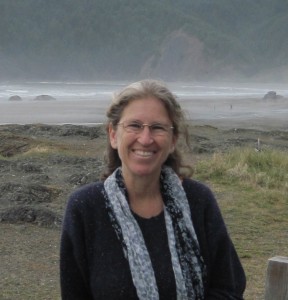


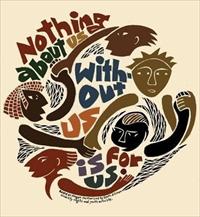
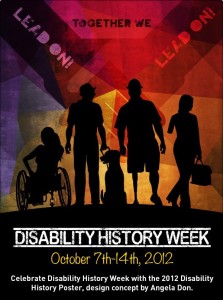
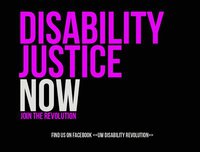
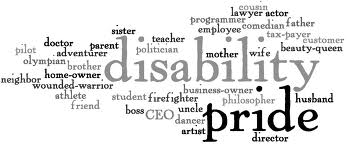

2 comments already | Leave your own comment
Dave Hingsburger
6/2/2012 | 11:14 am Permalink
Wonderful! I have had ‘person first’ language drilled in to me so deeply and so violently that it now comes out automatically. When speaking publically about disability, I need to use person first language to make non-disabled people comfortable! It’s like they love the fact that I have to state personhood while they take it for granted. It’s ok for me to say that I’m a gay guy … no one FORCES me to say ‘person who is gay’ and I’ve never said, ‘person who is a woman.’ However, non disabled people insist that I use language not created by me, about me. I don’t know where this came from but most disabled people I know are disabled people … not people with disabilities. The oddity about sitting in a wheelchair listening to a lecture on why I needed to use person first language from an outraged audience member is apparent only to me.
Dave Hingsburger
6/2/2012 | 11:15 am Permalink
I should have said ‘outraged non-disabled audience member’ sorry